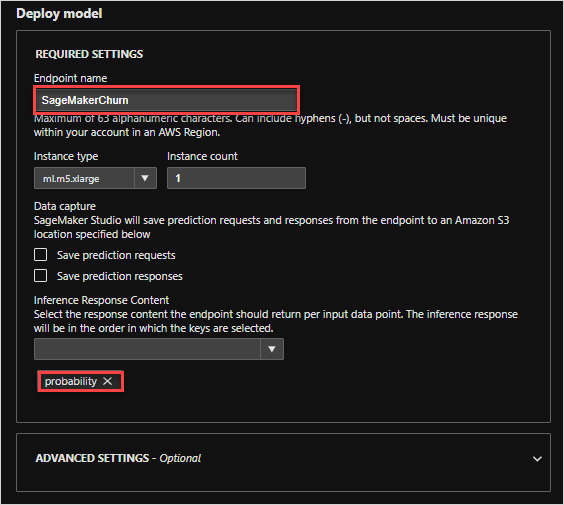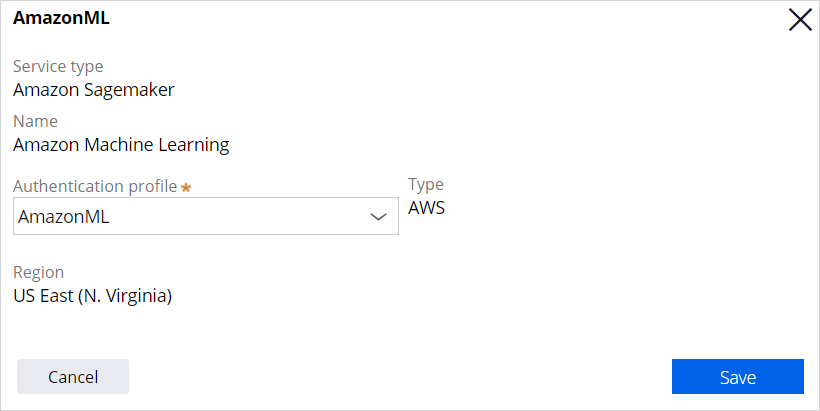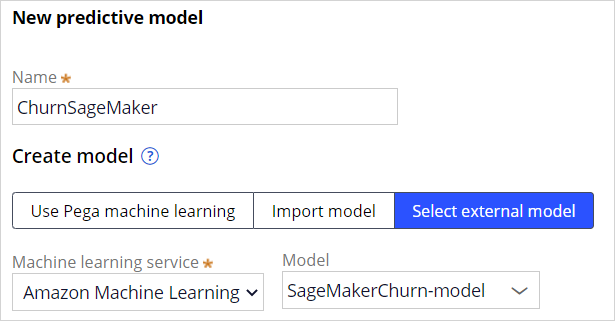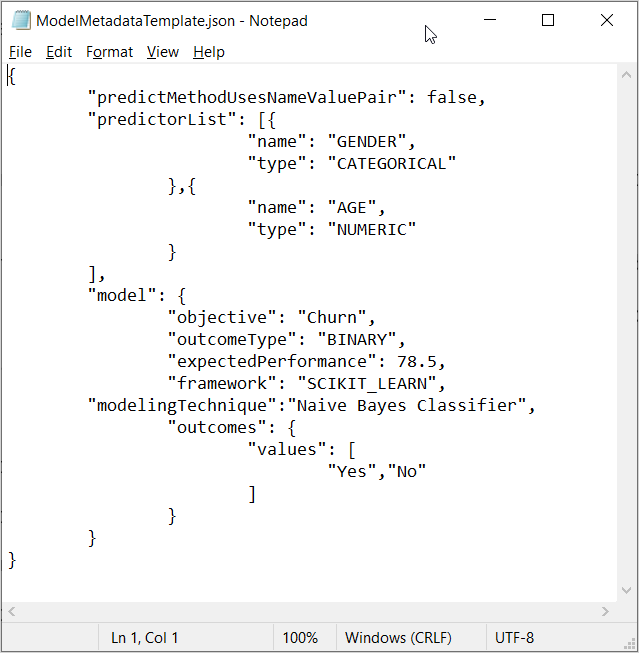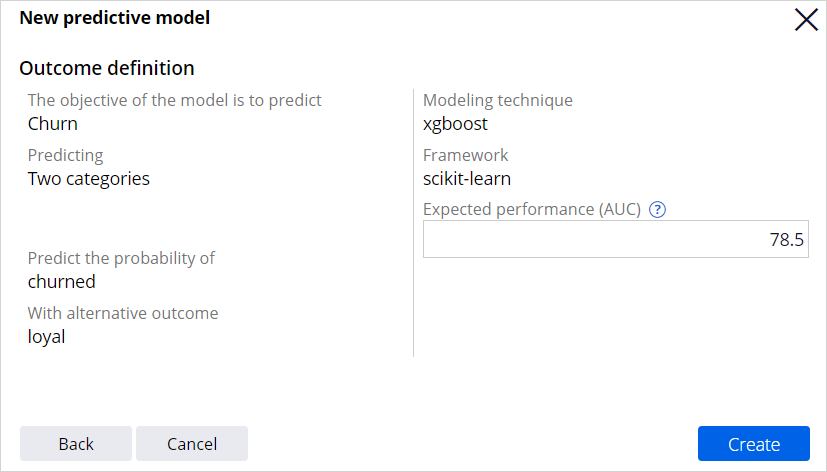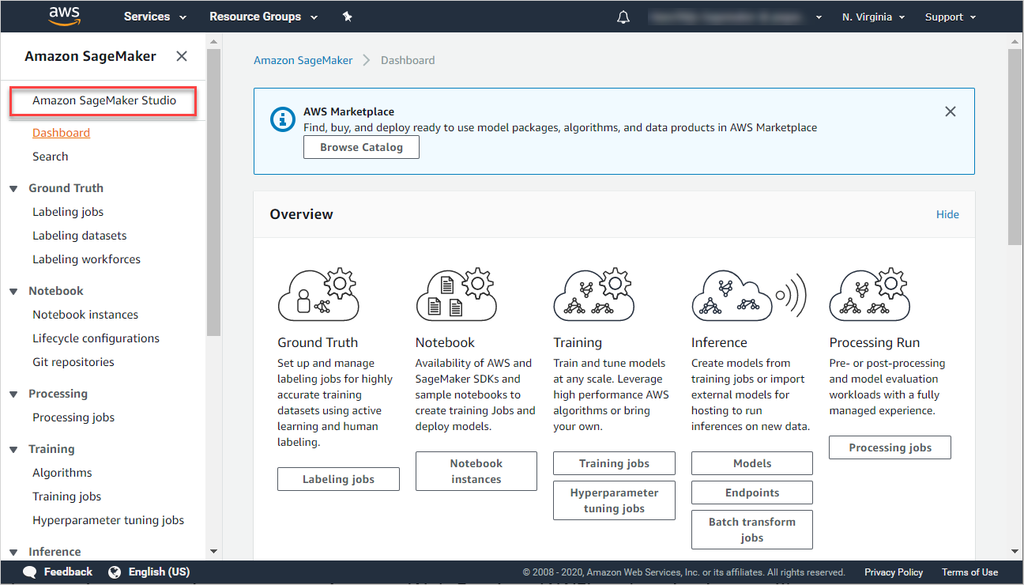
Using machine learning services
Introduction
Enhance the Pega AI engine with the latest AI algorithms by connecting to models in Amazon SageMaker and Google AI Platform machine learning services. Learn how to leverage a model, created in and running on Amazon SageMaker, in Pega's Prediction Studio.
Video
Transcript
This demo will show you how to leverage a machine learning service by running a churn model created externally and using its outputs in Pega Prediction Studio.
We will showcase this using Amazon SageMaker. The steps are similar to using other machine learning services such as Google AI Platform. Using a machine learning service instead of a model that runs locally may involve costs and possible down time of the service.
However, for certain use cases such as churn or credit risk models, machine learning services can be the optimal choice. To showcase how to use a churn model created in Amazon SageMaker, let's first consider the high-level steps involved in creating a machine learning model.
Amazon SageMaker allows you to build, train and deploy machine learning models in a fully managed service. The Autopilot feature automates this process and trains and tunes the best machine learning models for classification or regression, based on your data. After setting up your AWS environment, you can open Amazon SageMaker Studio to create a new Autopilot experiment.
In the Job settings, select the data file you want to build the model on, specify the outcome field, choose the location where the output should be stored and create the experiment.
The Autopilot process analyzes the data, performs a feature engineering step, and tunes the candidate models.
To deploy the best candidate model, select the tuning job with the highest Objective value. This value indicates the predictive power of the model.
An endpoint that can be reached from Pega is automatically created. A binary classification, as in this example, predicts if an event will happen or not, based on a cut-off value. By default, the response content for a binary model is set to this 'predicted_label'.
However, it is best practice to include a value for the probability that the event will happen in the response content as it contains the most information and allows the cutoff value to be adjusted in Pega. Also, it allows for monitoring of the probability with respect to observed outcomes over time.
In Prediction Studio, you can define a machine learning service to connect to your cloud service instance. To move messages securely to and from Pega, the system architect has set up an authentication profile.
Once the connection to the machine learning is established, start by creating a new predictive model to leverage the service. Select the machine learning service and the model that you want to reference.
Next, upload the required model metadata file. A template for this JSON file, containing example values, is available for download.
The JSON file must contain the list of predictors in the data set and their property type. It must also contain the objective of the model and the outcome type. Available outcome types are binary, categorical, and continuous. Optionally, include the expected performance. The metric for binary models is AUC, F-score for categorical models and RMSE for continuous models.
For SageMaker, the file must include the framework property. This property determines the input format and output format of the model. In Google AI Platform, this property is automatically fetched.
Finally, the metadata file must include the modeling technique and the outcome values. For binary outcome models, enter the values for the outcome for which you want to predict the probability, and the alternative outcome. For categorical outcome models, enter all values that represent the possible outcomes. For continuous outcome models, enter minimum and maximum outcome values. Best practice is to generate the file as part of the model-building process to avoid human errors.
Next, set the correct context of the model if required. The default context is the customer class. You can review the model metadata, such as the objective of the model and the type of problem to solve, before proceeding.
All predictors must be mapped to the corresponding fields in the data model. After saving the model, you can run it through the new service connection.
Customer Troy has a high risk of churning; the model returned a high probability to churn for him.
Customer Barbara will probably remain loyal; the model returned a low probability to churn for her.
By default, the results of the model are shown in the Results field. Model results are unique for each framework type on which a model is built. Pega offers full support for the xgboost, tensorflow, kmeanclustering, knn, linearlearner and randomcutforest frameworks.
Once the predictive model rule is created, it can be used in next-best-action strategies in a similar way as native Pega machine learning models and third-party models imported using PMML or H2O.ai. But there is an important difference to keep in mind. Native and imported models, using the required input data, execute inside Pega. In the case of machine learning services, the input data required by the model is sent to the external platform, the model is executed externally, outside of Pega, and the result is sent back to Pega using a secured connection.
You've reached the end of this demo. What did it show you?
- The high level steps involved in creating a model using Amazon SageMaker Autopilot.
- How to connect to external machine learning services and run a model externally.
This Topic is available in the following Modules:
If you are having problems with your training, please review the Pega Academy Support FAQs.
Want to help us improve this content?




